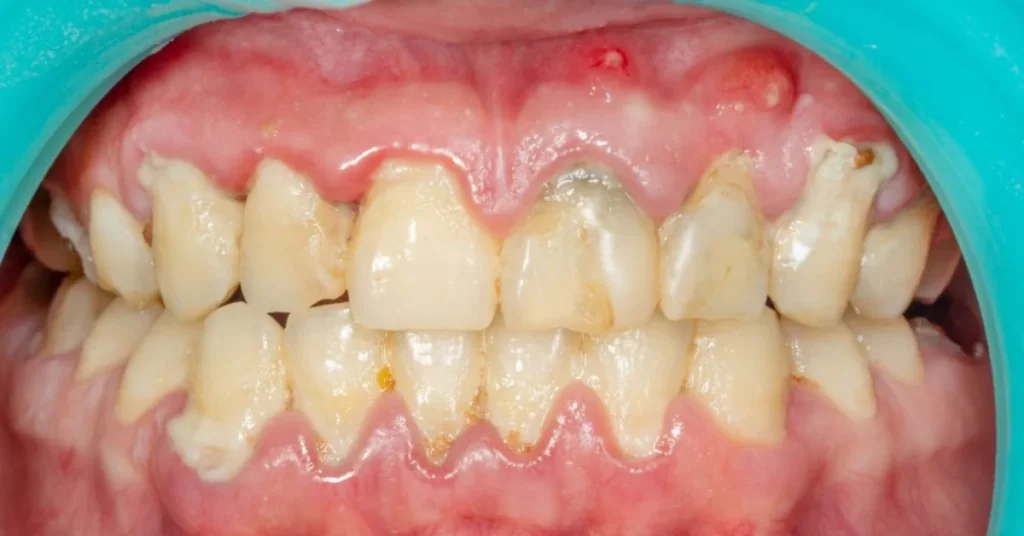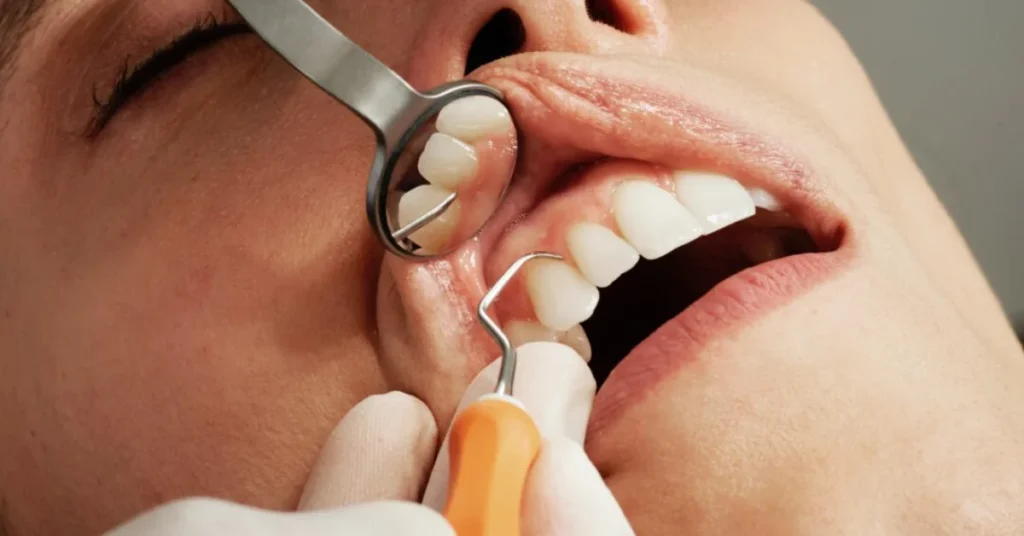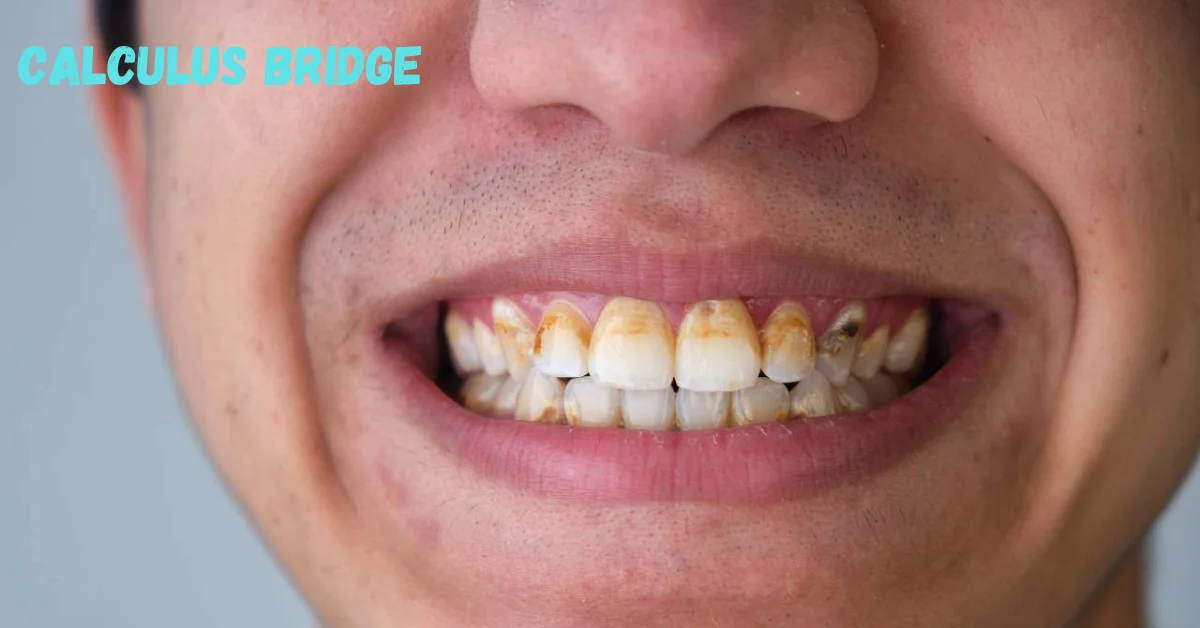Calculus Bridge: A Deep Dive into Dental Plaque and Tartar Buildup
Calculus Bridge is a frequent dental problem that can cause discomfort and suffering to people. It happens when plaque and germs accumulate on the teeth, forming a bridge-like structure between two teeth. It can result in a range of side effects, including tooth decay, gum disease, and tooth loss. In this post, we will look at the causes of the calculus bridge, the potential side effects, and how to prevent and manage this condition for good dental health. Understanding the basics of calculus bridge can help individuals take proactive measures to protect their teeth and maintain a healthy smile.
What Is Calculus Bridge?
A calculus bridge, also known as dental calculus, is a hardened deposit of mineral on the surface of the teeth caused by plaque buildup. When dental calculus forms and coats multiple teeth in a row, it subsequently fills in the intervening spaces, leading to the formation of a calculus bridge. This phenomenon occurs when the buildup extends across multiple teeth, filling in gaps and crevices along the gums.
How does Formation of Calculus Bridge occur?
Plaque is a viscous biofilm of bacteria, saliva, and food debris. Dental plaque develops on the surface of teeth and gums soon after consuming food. Plaque, if not eliminated by thorough brushing and flossing, undergoes a process of hardening and conversion into tartar (or calculus) for 24 to 72 hours
The procedure operates as follows:
Plaque Formation
Following food consumption, mainly those high in sugar or starch, microorganisms in the oral cavity consume these particles. As a result, acids are created, which have the potential to harm tooth enamel and create a cohesive coating of plaque.
Tartar Formation
Tartar forms when plaque on the teeth absorbs minerals from saliva and undergoes a process of hardening. Tartar is far more difficult to eliminate and often requires expert dental cleaning.
Bridge Formation
Over time, an increasing buildup of plaque and tartar spreads over numerous teeth, resulting in the formation of a calculus bridge.
Causes of Calculus Bridge?

Various elements influence the creation of calculus bridges.
Poor oral hygiene: Inadequate oral hygiene can lead to the collection of plaque and bacteria, resulting in calculus bridge formation.
Dry mouth: xerostomia can also contribute to this problem because it reduces salivary production, increasing germs and plaque buildup.
Brushing Habit: Improper brushing can cause plaque and calculus bridging.
In addition, practice proper dental hygiene to maintain your teeth healthy. Brush your teeth after smoking to keep them cleaner, especially if you have crooked or crowded teeth. Brushing and flossing can help remove plaque. Calculus cannot be removed by brushing alone, and waiting too long between dental visits can raise the chance of a calculus bridge. Addressing these factors helps to reduce the possibility of developing calculus bridges and preserve good oral health.
Side effects of calculus bridges
Calculus bridges occur when the dental plaque is not removed on time. As they go on piling up, calculus bridges can cause many side effects to the teeth and oral health. Here are some of them.
Halitosis
The medical term for persistent bad breath, halitosis is one of the most common signs of calculus bridges. Not every bad breath can be termed halitosis. The breath after eating certain types of pungent foods or after waking up can be cleared by brushing and using mouthwash. But in the case of halitosis, the bad breath is so chronic that it does not go away even after repeated brushing or using mouth freshener or mouthwash. It can cause many types of gum diseases such as gingivitis and periodontitis.
Gum infections
Gum infections are among the most common side effects of calculus bridges. The early stage of bacterial infection is known as gingivitis, in which the gums become red, swollen, and bleed from inflammation. Gingivitis, however, can be reversed with the right oral hygiene and a nutritious diet. But in the advanced stages of gum infections such as periodontitis, the gums become severely inflamed, and pockets of pus form between gums and teeth. If periodontitis is not treated on time, it can cause tooth loss as well as deterioration of the jawbone and dental tissues.
Receding gums
Receding gums are another common complication caused by calculus bridges. If the gum infections are not treated on time, the bacterial progression corrodes the connective tissue and exposes the roots of teeth. That not only leads to receding gums but also results in massive bone loss.
Cavities and caries
When calculus bridges stick on teeth for long the bacteria in them emit acids as a byproduct. As the acids corrode the enamel, cavities and caries are formed on the dental surface. If left untreated, cavities can advance to the dentin and pulp and cause sensitivity, pain, infection, abscesses, and many other dental complications.
Tooth loss
Tooth loss is among the most common side effects of calculus bridges. If cavities, gum infections, and tartar buildup are not treated on time, the complications can ultimately result in tooth loss.
Read Previous: Michael quandt born wurchow pommern
What are the Steps to Diagnose Calculus Bridge?
To address calculus and mitigate any consequences, it is necessary to have a dentist diagnose the disease. A dentist gathers medical history and does the following diagnostic examinations:
Dental X-ray
Dentists use dental X-rays to detect and evaluate the presence of calculus accumulation between teeth and at the bottom of gum pockets. This evaluates any damage to teeth or underlying bone.
Dental exam
The dentist evaluates the extent and magnitude of calculus above and immediately below the gum line. In specific applications, compressed air enhances the visibility of deposits.
Probing exam
Dentists use specialised instruments, like probes or a five-pointed explorer, to assess the depth of pockets (the gap between the gum and tooth) and examine them for indications of calculus formation below the gumline.
Procedures to remove calculus bridges

Professional dentists can remove calculus bridges by using their expertise, experience, and of course, many specialized tools. The removal procedure of calculus bridges mainly happens in three phases.
- Dental scaling: This is a cleaning procedure in which a dental hygienist uses specialized tools to remove calculus deposits from the enamel of teeth as well as below the gum line. The dentist generally uses a dental scaler, a handheld tool with a small hook on the end, which remove calculus deposits quite efficiently.
- Polishing: After dental scaling, the dental professional will smooth out the tooth surfaces. This not only enhances teeth’s appearance but also prevents bacterial buildup as the enamel becomes extremely polished.
- Deep cleaning: This procedure, also known as scaling and root planning, eliminates calculus bridges most efficiently. In this stage, the dental hygienist applies local anesthesia to the gums and scrapes away calculus from the crowns of teeth and below the gum line.
Prevention Strategies For Calculus Bridge
Preventing the formation of a calculus bridge involves maintaining proper dental hygiene and regular dental visits. There are a few simple daily steps you can take to prevent calculus formation. The American Dental Association (ADA) recommends the following steps to keep your mouth healthy and tartar-free:
- Brush Twice Daily: Use fluoride toothpaste and spend a full 2 minutes brushing each time.
- Floss Daily: Clean between your teeth to remove plaque and debris.
- Limit Sugary & Acidic Foods: Reducing the intake of these foods minimizes plaque formation.
- Regular Dental Checkups: Visit your dentist regularly for checkups and professional cleanings.
Treatment Options for Calculus Bridge
Professional Deep Cleaning and Scaling
One of the most common treatments for a calculus bridge is a professional deep cleaning, also known as scaling. During this procedure, a dental hygienist or dentist uses specialized tools to scrape away the hardened tartar from the surface of the teeth and below the gumline. Scaling helps remove the bulk of the tartar, reducing the bacterial load in the mouth and preventing further damage to the teeth and gums.
Root Planing
In more advanced cases where the calculus bridge has extended below the gumline, root planing may be necessary. This procedure involves smoothing out the root surfaces of the teeth to remove any remaining tartar and bacteria. Smoothing the roots helps the gums reattach to the teeth, reducing pocket depth and promoting healing. Root planing is typically done under local anesthesia to ensure patient comfort. According to the CDC publication, 29.5% of adults aged 30-44 years have some form of periodontal disease.
The Role of Dental Professionals
The role of dental professionals is instrumental in identifying, treating, and preventing the formation of calculus bridge. Their expertise enables them to accurately diagnose the condition and suggest the most suitable course of action. Dental professionals can provide treatment options such as scaling and root planing to aid in the removal of calculus bridge and the restoration of the patient’s oral health. Moreover, dental professionals can offer counsel and direction on how to forestall calculus bridge, including correct oral hygiene and regular dental visits. Adhering to the guidance of dental professionals ensures sustained optimal oral health and prevention of calculus bridge and other dental issues.
FACTS
- Formation Process: Calculus bridges form when plaque, a soft biofilm of bacteria, is not removed regularly through brushing and flossing. Over time, the plaque hardens due to the minerals in saliva, creating calculus (tartar).
- Risk to Oral Health: The rough surface of a calculus bridge can harbor bacteria, increasing the risk of gum inflammation, gingivitis, and eventually periodontitis (advanced gum disease). It can also cause bad breath and discoloration of teeth.
- Common Areas: Calculus bridges often form behind the lower front teeth and along the gumline of the upper molars, where salivary glands release minerals that can speed up plaque hardening.
- Removal Methods: Unlike regular plaque, a calculus bridge cannot be removed with a toothbrush. It requires professional cleaning by a dentist or dental hygienist, who uses special tools like scalers or ultrasonic devices.
- Potential Symptoms: Besides visible deposits, symptoms of a calculus bridge can include swollen, red, or bleeding gums, sensitivity, and receding gums, exposing more of the tooth and possibly causing mobility.
FAQs
What is a calculus bridge?
A calculus bridge is a hardened build-up of plaque, also known as tartar, that forms along the surfaces of teeth, particularly near the gumline. When left unremoved, plaque hardens into calculus and can form solid, bridge-like deposits between teeth.
How does a calculus bridge form?
It forms when plaque, a sticky bacterial film, is not thoroughly removed through daily brushing and flossing. Over time, the minerals in saliva harden the plaque into a solid mass, creating calculus that bonds to the teeth.
Can I remove a calculus bridge at home?
No, once plaque hardens into a calculus bridge, it cannot be removed with a toothbrush or at-home cleaning methods. Only a dentist or dental hygienist can remove it using special tools.
What are the risks of not treating a calculus bridge?
Untreated calculus bridges can lead to gingivitis, periodontitis, gum recession, and even tooth loss. They can also cause persistent bad breath and lead to infections that affect overall health.
What are the symptoms of a calculus bridge?
Symptoms can include visible deposits on teeth, swollen or bleeding gums, tooth sensitivity, bad breath, and receding gums. In advanced cases, teeth may feel loose due to gum disease.
Conclusion
Calculus bridge is a significant dental concern that arises from the hardening of plaque into tartar, creating solid deposits along the gumline and between teeth. While it may seem like a common oral issue, leaving a calculus bridge untreated can lead to serious health implications, including gum disease, tooth decay, and even tooth loss. Since a calculus bridge cannot be removed at home.
Stay in Contact With: Webtoonxyz!






